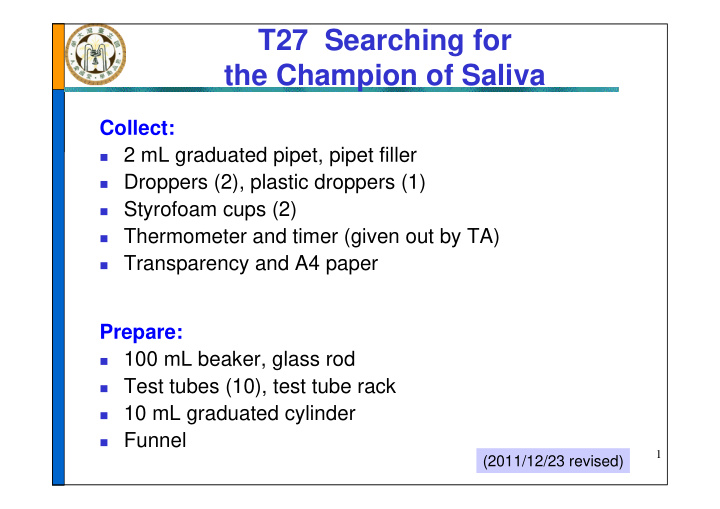



T27 Searching for the Champion of Saliva Collect: 2 mL graduated pipet, pipet filler Droppers (2), plastic droppers (1) Styrofoam cups (2) Thermometer and timer (given out by TA) Transparency and A4 paper Prepare: 100 mL beaker, glass rod Test tubes (10), test tube rack 10 mL graduated cylinder Funnel 1 (2011/12/23 revised)
Objective Learn the iodine test Determine the catalytic efficiency of salivary amylase for the hydrolysis of starch Investigate the factors that affect the activity of the enzyme 2
Amylase in Saliva Saliva: • To keep our mouth moist and clean • Moisten the food for easier swallow • Helps digestion Amylase: Catalyze hydrolysis of starch 3 Computer modeling of amylase
Characteristics of Enzymes Characteristics of enzymes Enzymes are usually proteins in nature The enzymatic catalysis is highly specific (usually work on a specific substrate) The enzymatic catalysis is highly efficient The enzymatic catalysis is highly affected by environmental conditions, such as pH, temperature…etc. 4
Iodine Test of the Catalytic Activity of Amylase I - + I 2 → I 3 - (Iodine indicator) Starch - I 3 Blue-black complex Brown Amylase Oligo- Amylase Maltose - /starch I 3 saccharide Hydrolysis ( Yellowish Hydrolysis (Blue-black soln.) ( Red-Brown) -Brown) The higher the efficiency of the catalyst, the shorter time it takes to 5 complete the hydrolysis reaction.
Procedure I. Catalytic Activity of Amylase Clean and dry 10 test tubes Prepare reacting Take one transparency soln. Prepare salivary amylase soln. - 1 mL of 2% starch soln. - 1 mL saliva (self-produced) - Add 1 mL of pH 7 buffer - Add 25 mL of 0.5% NaCl Use plastic dropper to - Mix with glass rod drop iodine soln. on - Record soln. temperature cells of transparency Prepare 5~10 drops of iodine testing soln. 6
Procedure I. Catalytic Activity of Amylase 2. Use dropper to take and 1. Obtain 2 mL salivary drop the reaction mixture amylase soln. with 2 on the iodine testing soln. mL graduated pipet on transparency Add to soln. and start timing Test the activity every 30 s. or 1 min. 3. Observe and record the time until blue-black color disappears Starch in pH 7 buffer soln. Note: Avoid the tip of dropper touching the droplet of reacting soln. for contamination Obtain fresh reaction mixture in test tube for each testing 7
Procedure II. Effect of pH on Catalytic Activity Note: 1 mL of pH 5 or 9 buffer soln 1 mL of 2% starch soln. Wash and rinse the dropper for each trial Compare catalytic activity of amylase in pH 5, 7, and 9 buffer solutions pH 5 pH 9 buffer Add 2 mL salivary amylase soln. Iodine test Observe and record the reaction time 8
Procedure III. Effect of Temperature on Catalytic Activity 1. Obtain 2 Styrofoam cups and prepare 80 o C hot-water bath Mix the soln. in Prepare two test tubes two test tubes Iodine (1) 2 mL salivary amylase to react (2) 1 mL starch soln. and 1 mL test for Place the tube pH 7 buffer back in hot- 10 min. Place in hot-water bath for water bath 5 min. Start timing Cool the test tube and bring the temp. of reaction mixture back to room temp. Test the activity for another 5 min. 2. Repeat the above steps in 0 and 50 o C water bath 9
Compare Catalytic Activity of Salivary Amylase with Classmates Who is the champion of saliva? 10
Notice Salivary amylase solution and reacting solution should be mixed quickly and start timing at the same time Hot water is heated in fume hood Hot-water bath should be close to or equal to 80 o C (avoid getting burnt) Transparency should be rinsed with water, wiped dry, and handed back along with A4 paper Hand in plastic droppers used for iodine test to recycle 11
Recommend
More recommend